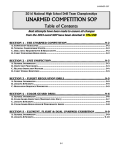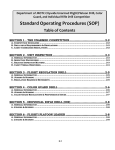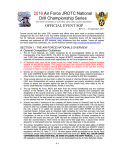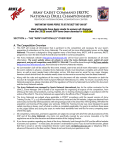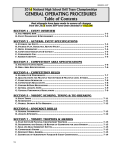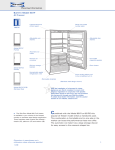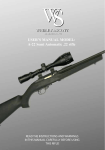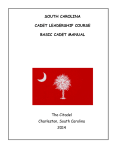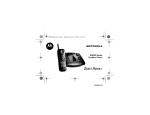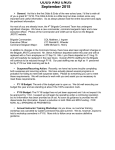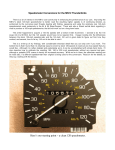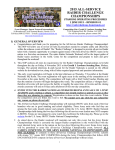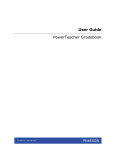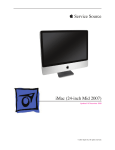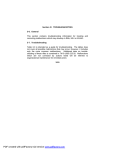Download NHSDTC Armed Division SOP
Transcript
ARMED SOP 2016 National High School Drill Team Championships ARMED COMPETITION SOP Table of Contents Best attempts have been made to ensure all changes from the 2015 event SOP have been denoted in YELLOW. SECTION 1 - THE ARMED COMPETITION .......................................... 8-2 A. COMPETITION GUIDELINES ............................................................................................. 8-2 B. NATIONAL CHAMPIONSHIP EVENTS................................................................................... 8-2 C. DRILL RIFLE REQUIREMENTS & REGULATIONS ................................................................... 8-2 D. CADET COMMANDER REGULATIONS.................................................................................. 8-3 SECTION 2 - UNIT INSPECTION ........................................................ 8-4 A. GENERAL INFORMATION ................................................................................................. 8-4 B. INSPECTION PROCEDURES .............................................................................................. 8-4 C. RELATED INSPECTION MATTERS ...................................................................................... 8-5 D. CADET VERBAL RESPONSES ........................................................................................... 8-6 SECTION 3 - PLATOON REGULATION DRILL ..................................... 8-6 A. GENERAL INFORMATION ................................................................................................. 8-6 B. JUDGING & SCORING .................................................................................................... 8-6 C. REGULATION DRILL SEQUENCE MOVEMENTS ...................................................................... 8-7 SECTION 4 - COLOR GUARD DRILL .................................................. 8-7 A. GENERAL INFORMATION ................................................................................................. 8-7 B. COLOR GUARD INSPECTION (MASTERS LEVEL ONLY) ........................................................... 8-8 C. JUDGING & SCORING .................................................................................................... 8-9 D. COLOR GUARD REGULATIONS & PERFORMANCE ISSUES ...................................................... 8-9 SECTION 5 - SOLO, DUAL, SQUAD, PLATOON & TEAM ARMED EXHIBITION 8-10 A. GENERAL INFORMATION ................................................................................................ 8-10 B. JUDGING & SCORING ................................................................................................... 8-11 8-1 ARMED SOP 2016 National High School Drill Team Championships ARMED COMPETITION SOP REGULATIONS FOR ALL ARMED DIVISIONS MASTERS & CHALLENGE LEVEL COMPETITIONS & OPEN LEVEL COLOR GUARD COMPETITION SECTION 1 - THE ARMED COMPETITION A. Competition Guidelines 1. The Armed Division competition score sheets as well as all levels of Color Guard have been written under the guidelines of the Army TC 3-21.5. However, as stated within the Overall Competition SOP, teams may use any one of the three major service manuals for competition at the NHSDTC. The only exception to this is the Color Guard competition may ONLY be executed using the MCO P5060.20 w/change 1 OR the Army TC 3-21.5 (most recent version available). Only the modifications contained within this SOP will be allowed. Any team wishing to obtain a copy of any service manual should look on the Nationals website with this direct link: http://www.thenationals.net/judgeregs-MANUALS.htm 2. The NHSDTC allows all units to perform in accordance with the requirements outlined in their particular service manual with few exceptions. However, portions of some events WILL REQUIRE the use of the Army manual (as in Case/Uncase Colors in Color Guard or all rifle movements for Air Force teams within Armed basic event drill). Specifics on EXACTLY HOW THIS MUST BE DONE are listed in detail under both the Regulation and Color Guard segments of this SOP. This drill meet SOP has been studied by drill instructors from all services ensuring that it maintains the fairest all-service drill meet format possible. 3. In the Challenge Level Armed division, all teams must drill with demilitarized drill rifles. Any team drilling with lightweight facsimile drill rifles must compete in the Mixed Division competition held during the two-day Masters Level competition of the NHSDTC – no exceptions. Teams found later to be utilizing a facsimile drill rifle in the Demilitarized Division or in the Challenge Level Armed Division will be subjectively penalized by the Judging Director, up to and including a full disqualification. 4. Teams should review the General Operating Procedures in its entirety before readying their unit for the NHSDTC. B. National Championship Events 1. The events counted towards the National Championship in the Challenge Level are: Unit Inspection, Platoon Regulation, Color Guard, and Team Exhibition. The events counted towards the National Championship in the Masters Level are: Unit Inspection, Platoon Regulation, Color Guard, and Squad Exhibition and Platoon Exhibition. Other events are held but are not a part of the Overall Championship scoring. Overall finish is determined by placement valuation in each event (see page 7-9 – 5-C-1 for details). C. Drill Rifle Requirements & Regulations 1. To compete at the NHSDTC within all armed events (except events maintained within the Mixed Division), the unit's drill rifle must fit a series of standards that qualify it to be "demilitarized". These criteria include the following: A drill rifle must be rendered demilitarized by leading the barrel or removing firing pin A drill rifle must weigh a minimum of 8 lbs. A drill rifle must contain both a trigger guard (if trigger is present) and an adjustable sling 2. Should a drill rifle not meet any one OR MORE of the above criteria, the team will be considered to be using facsimile drill rifles and will be penalized in an amount to be determined on-site by the judging director based on the severity of the drill rifle violation. Scales are used at the event should a question arise about the weight of any drill rifles. 3. It should be noted that unaltered Glendale and Daisy standard drill rifles meet all of the above criteria. 4. The use of front/rear sights are strongly discouraged by SNI on any drill rifle used for a team's exhibition performance. They can cause severe injuries and serve little purpose on these drill rifles. 8-2 5. ARMED SOP Any male–female or all-male drill team utilizing a drill rifle between 5lbs. and 8lbs. may be placed within EITHER the Demilitarized Arms Division or the Alternative Armed Division of the Masters Level. This decision and placement is at the SOLE DISCRETION of the Judging Director of the NHSDTC and will be based on many factors. Teams who have drill rifles which fall into this “gray area” MUST contact SNI in advance to get a drill rifle status clarification to ensure they register and compete within the correct competition division at the Nationals with minimal or no out subjective penalty. 6. The Master’s Mixed Division does not require a sling to be attached to the drill rifle (except of course during the color guard competition). In the Masters Demilitarized and Challenge Armed Divisions, drill rifle slings are required drill rifle equipment and may not be "taped down" or otherwise attached to the stocks of drill rifles during any phase of the competition except during exhibition events at the Nationals. Otherwise, all armed teams may apply tape, rubber bands or other materials to a drill rifle as they see fit. 7. Although all team members must compete with the same style drill rifle during a given event, teams are allowed to use multiple sets of drill rifles for each team event (example: one set for Regulation Drill and a different set for Exhibition). All female teams entering the Mixed division can compete with either demilitarized or facsimile drill rifles. Therefore, these teams could utilize demilitarized drill rifles for one event (Inspection, for example) and use facsimile drill rifles for others (Exhibition events). This is left to the discretion of these teams. 8. Color Guard units competing within the Open Level Color Guard competition, as well as the Masters Level Mixed Division & Unarmed Division may use any style or weight drill rifle they choose, so long as the drill rifle has a sling which is required to execute all commands within the color guard sequence. Challenge Level Armed and Masters Level Demilitarized color guard units MUST utilize a demilitarized drill rifle as outlined within the Nationals drill rifle Requirements & Regulations. 9. Judges will be instructed that a DROPPED RIFLE will be penalized when the cadet UNINTENTIONALLY loses TOTAL rifle control and the rifle strikes the marching surface before gaining control. This is critical during all armed exhibition drill events (both team and solo/dual) where a 25-point penalty is imposed for every occurrence of a dropped drill rifle. Drill rifle control is ESSENTIAL to a solid finish! 10. AS PER DIRECTION FROM EACH SERVICE HQ, the drill rifle cannot be driven into the marching surface by the BARREL! Judges generally do not LIKE IT, and therefore teams should NOT execute it. A subjective deduction can be maintained by the judges and/or the Competition Director if it is witnessed. 11. Drill rifles sometimes break in a way where its continued usage could become a danger to the cadet, nearby cadets and/or spectators. When this occurs, the cadet should carry the drill rifle but UNDER NO CIRCUMSTANCES should the drill rifle be spun or otherwise moved in a dangerous manner. See page 7-9 (4F-11) for regulations on replacing a broken drill rifle during a routine. 12. ALL exhibition judges WILL BE INSTRUCTED TO take control of and visually inspect/hand-weigh a cadet's drill rifle at random in the event ready area just before all solo, dual, & team exhibition performances in all armed events. If a question as to the weight of the rifle arises by a judge, the rifle may be weighed on a scale for a further clarification of the total weight. This will be done BEFORE watching the team perform to ensure the judge maintains a clear picture of the degree of difficulty the weapon presents during their routine. D. Cadet Commander Regulations 1. Armed competition cadet commanders MUST carry a rifle, saber or sword (note-only a rifle in the Color Guard event). When a commander uses a saber or sword, it is not permitted for this item to leave the commander's hand at any time upon entering the drill floor. (This prevents any attempt at flipping or tossing). 2. When using a saber/sword, the commander should maintain EXTREME control and use proper distance spacing around the Head Judge when reporting in and out. Violation of this rule will cause the Head Judge to retreat to a safe distance away from the commander. Although there is no specific deduction for this action, the result is reflected in the overall evaluation scoring from the event Head Judge, as well as the other event judges. 3. Allowing that each drill team is instructed differently, judges will evaluate the vocal projection of cadet commanders in the following manner. During Inspection and Regulation Drill events, an individual's voice projection, confidence, and tone will be the criteria upon which judges will base their evaluations. 4. CADET COMMANDERS WILL NOT MOVE TO REVIEW THE CADETS FOR PERFECT DRESS & COVER DURING ANY BASIC EVENT(S)! Cadets will dress & cover only. Cadets at this level are expected to maintain adequate dress & cover without supplemental review from the Cadet Commander. Cadet Commanders who move to review the ranks will be graded down for their efforts - DON’T do it! 8-3 ARMED SOP SECTION 2 - UNIT INSPECTION A. General Information 1. Teams will formulate their Unit Inspection team in the same way that they do every other team at the Nationals. The team selects the 12 cadets who stand Unit Inspection, as well as select the Cadet Commander for the detail. 2. Inspection at the 2016 Nationals and beyond will have a different tenor than past years. While still designed to be an intense experience, the judges will be briefed, trained and monitored to ensure a different standard is displayed. Inspection questions will ONLY come from FIVE primary areas. These will be military, governmental, historical, current events and first aid. These broad topics will have questions formulated well in advance and will be broken down into easy, medium and hard questions. These questions will NOT be given to the teams in advance. There will be HUNDREDS of questions available to the judges for use and therefore they will likely not be many except the most basic that could be repeated throughout the day. Judges will also be encouraged to ask cadets thought provoking questions involving moral issues, likely ending with, “and WHY” where the cadet will be expected to explain their logic, reasoning or answer in detail to the judge. 3. Judges will maintain a strong presence and cadets should be expected to have impeccable bearing. Judges will provide immediate feedback on deficiencies to the cadet during the review. 4. This scoresheet should be studied to see how your performance can receive the maximum score in each area. B. Inspection Procedures 1. Just prior to the Inspection, spectators with the performing team will be asked to enter and sit inside the Inspection room in the spectator seating area. The unit forms outside the Inspection room in the hallway near the entrance door. Cadet Commander’s with rifles must utilize the position of Sling Arms if using a rifle throughout the Inspection. 2. The Head Judge will approach the cadet commander in the hallway as the parents enter the room, impart a few words of wisdom, ensure the unit is ready, and then return back into the Unit Inspection room. The Head Judge will ensure the other judges are ready, and then command in a loud voice, “XYZ High School, REPORT”! The Cadet Commander will then verbally command the unit to enter the Inspection area through a 72” doorway (double doors – 36” each). An extra cadet, parent or team follower should open, hold and close the door(s) for this entry. 3. The unit will be formed with 4 squads of 3 cadets each and centered on the Head Judge in the formation as shown on the next page. Teams forming into three squads of four cadets will be ripped by the judges! Teams should NOT simply command “Fall In” and double time into the area. Judges want to see a unit commanded and marched into the inspection room. How you choose to do this is up to your team. 4. Once inside the room, the Cadet Commander halts the platoon and faces the platoon, if necessary. At this point, the Cadet Commander will command, “Open Ranks, March”, “Dress Right, Dress” “Ready Front”, execute an About Face, salute, and Report In to the Head Judge with the unit at attention. Due to the room size, units must be centered and should not “crowd” the Head Judge when executing “Open Ranks”. Done correctly, the C/CDR should be a minimum of two paces away from the Head Judge. Important Note! Instructors, you control the Inspection Room! Only those spectators who are with your program should be inside your inspection. An SNI staff member may enter the room to ensure the judges are following the correct procedures during their interaction with your cadets but these people are easily identified. If someone attempts to enter your inspection room and after speaking with them you do not wish to have them inside your inspection, you have the right to ask them to leave. If they do anything but comply fully, tell the head judge to radio for the Competition Director and that individual will be removed from the area immediately by SNI staff. 5. To report in correctly, the Cadet Commander should state: 1)school name & team name; 2)city & state you are from; 3)the drill manual you will perform in accordance with and 4)the military "reg" your uniform is inspected under (AR 670-1; MC Order P1020.34F; AFROTC 36-9, etc.). NOTE: DO NOT have the entire formation salute the judge – this will likely be considered an exhibition movement! 6. After Report-In, the Head Judge will inspect the commander briefly (commander remains at Sling Arms). The Head Judge will tell the commander, "PRECEED ME through the Inspection" or similar. Cadet Commander will follow these instructions and LEAD the Head Judge, staying one cadet slot ahead of the judge. The remaining three judges will then step off and begin their Inspection of the other squads. As the inspector halts in front of each cadet, the cadet should execute Inspection Arms. The inspector WILL LIKELY take your rifle. 8-4 7. ARMED SOP Cadets in ranks should provide a very brief greeting to the Inspection judges when a judge halts in front of them (BEFORE they move to “Inspection, Arms” in the Armed Division). An example would be, “Good morning Staff Sergeant, Cadet Phillips ready for your inspection” or similar. The name and rank of each judge listed by the squad they will be inspecting will be posted just outside the competition area entry door. # st 8. When the Head Judge inspects cadet 3 of the 1 squad, the cadet commander is “in space” to the judges right. When completed with the final cadet inspection in their rank, the head judge then cuts in front of the cadet st commander and moves to the rear of the 1 squad and at that point the cadet FOLLOWS the head judge. When the judge reaches the end of the rank, both the judge and the cadet move to their original positions at the front of the formation. The cadet then FACES THE UNIT to ensure ALL judges have completed their inspection. 9. When all judges have completed their inspection, the cadet commander FIRST will verbally report out to the Head Judge. Upon reply by the judge, the cadet commander will THEN execute “About Face”, execute “Close Ranks, March” and then execute "Column of Files" (squad leaders give appropriate supplemental commands) to exit through the exit doorway. On “Close Ranks, March”, an extra cadet, parent or team follower moves quickly and quietly to open and hold the exit door for the team. Because a doorway is involved, the Cadet Commander should remain inside the room and follow the 4th squad out the door as they leave. 10. After exiting the room, the team should move away from the exit door and QUIETLY bring the unit to a halt, then dismiss the unit. All parents and spectators leave immediately after the team. New in 2016, it is requested that the unit instructors be the last ones out of the room and we encourage you to shake the hands of the four judges. It is not a time to have any real discussion, but we believe this act is important to set the right tone of a less adversarial appearance between the judges and the teams. 11. A single instructor or other designated team representative is encouraged to wait for the runner to execute the Scoresheet Review in the hallway area outside the exit door in the hallway. 12. A map is enclosed following page 6-1 in the school folder describing entrance, formation and exit of the Inspection drill areas (H & I). The formation of the unit must be done exactly as shown in the map and in this description. Please do not ask if you can use a similar formation, entry or execution method; all teams use the method outlined. SPECTATORS See Layout Following Sqd. Ldrs. Page 6-1 in folder for complete directions Exit Door x x x x x x x x x x x x = Cadets = C/Commander = Judges = Head Judge x = Spectators chairs Entry Door C. Related Inspection Matters 1. Hair length and other grooming issues should correspond to the team's particular service regulations. General appearance should be well-groomed and uniforms should be impeccably clean. 2 Teams will be inspected using their own uniforms as “the standard”. The way one looks, is the way they all should look. The difficulty any given uniform takes to ready itself for Unit Inspection (amount of brass and other peripheral items) will certainly be taken into consideration when judging the appearance of a cadet. Cadets ARE EXPECTED to wear THEIR uniform to include ALL authorized ribbons, etc. appropriate for that uniform – no exceptions! 3. Leather shoes or corfram shoes are appropriate wear for all portions of the NHSDTC. While corframs are comparatively easy to maintain, leather shoes require more effort to achieve the same appearance and must be so maintained. Should corfram shoes be worn, absolute perfection will be needed to achieve the same score as a well-maintained leather shoe due to the additional difficulty involved. 8-5 ARMED SOP D. Cadet Verbal Responses 1. Unit Inspection will include roughly 3-5 questions for each cadet to determine a cadet's poise, confidence, and overall military/governmental/historical/first aid/current events knowledge. Again, judges will be strident and possibly imposing to a high school cadet, however they will not be screaming, nor touching the cadet or anything on the cadet. Study, but know that a Nationals’ Inspection will test knowledge, thinking on your feet and bearing! 2. If a cadet doesn't know the answer to a question posed to him/her, a confident, "Sir, this cadet does not know at this time, sir!" or similar is the best response. 3. If a judge incorrectly applies a regulation to your team's service branch or other type of mistake, do not belabor the point with the judge during Inspection! If the judge presses a point a cadet knows is incorrect, the correct response should be "Sir, this cadet has been instructed that "thus & so" is correct, sir". Do not lose military bearing! After ending the Inspection process, immediately reach the SNI judging director and the issue will be immediately resolved. SECTION 3 - PLATOON REGULATION DRILL A. General Information 1. The required sequence movements must be done regardless of the team's service affiliation, in the order they are listed. This allows every team to perform in other languages & dialects, along with allowing service variations (i.e., “rear march” vs. “to the rear march”, etc.). Obvious mis-statements by the commander may result in deductions. 2. ALL UNITS MUST UTILIZE A STANDARD, FULL 30” STEP REGARDLESS OF SERVICE AFFILIATION. 3. Team Commanders MUST be armed with either a rifle, saber or sword. The cadet commander should Report in and Report Out 6 paces and centered from the Head Judge. 4. Air Force units competing in ARMED Regulation may drill using their own Air Force 36-2203 manual. While drilling with rifles, Air Force schools looking to compete under AF regs will execute all RIFLE movements as listed in the Army manual. The only change to this manual is during Parade Rest, the left hand goes to the tailbone vs. small of back in Army regs), NOTE: You will still do double pivots on columns, open ranks without backwards march, call forward march coming out of columns, all marching regs etc. as required by your regs!) Again, ONLY the RIFLE items are the required MODs to use the Air Force regs while drilling under arms). B. Judging & Scoring 1. The Regulation Drill sequence is composed of many individual scoring opportunities. Also, teams will receive point scores for their report in and report out, and points for the judge’s overall impression of the routine, for a grand total of 300 points, per judge. 2. Some of these movement combinations are relatively easy while a few are quite difficult. While the execution of many of these movements within the given drill area is challenging for any drill unit, it can be executed by any well-prepared team worthy of attending the Nationals at any competition level. The unit's ability to perform this sequence without extra commands or shortening steps is vital to the team's overall success at this meet. 3. The position of the Head Judge is fixed and denoted by a large “X” placed on the floor. Teams will report in & report out to this spot. It is responsibility of the Head Judge to ensure he or she is on this spot during both the report-in and report-out. See enclosed drill area layout for the exact position of the Head Judge. 4. To report in correctly, the Cadet Commander should state: 1)school name & team name; 2)city & state you are from; 3)the drill manual you will perform in accordance with. NOTE: DO NOT have the entire formation salute the judge – this is an exhibition movement! 5. The 15-Count Manual of Arms (14-count for Navy/Marines) should be executed at Quick Time (120 cadence). 6. A single instructor or other designated team representative can wait for the runner to execute the Scoresheet Review in the hallway area by the exit. 8-6 ARMED SOP C. Regulation Drill Sequence Movements 1. The sequence is designed to be executed with THREE squads/elements of FOUR cadets each. No other formation is possible to execute the drill correctly. 2. All of the prescribed movements in the Regulation Drill sequence are located on the event scoresheet. 3. All teams should carefully review the Regulation Sequence to ensure their entry and/or exit from the drill floor keeps the squad leaders in the correct position to execute the drill as written. Teams may find the need to execute SEVERAL column movements to properly enter and/or exit the drill floor. Important Note! Judges are encouraged to discuss matters of rule interpretation, boundary violations, and missed commands among themselves immediately after both Regulation and Color Guard sequences. With the all-service format of the event, this remains the best way to ensure a school is graded correctly. Judges DO NOT discuss matters of preference or opinions regarding a performance AT ANY TIME PRIOR TO THE AWARDS CEREMONY. This concluding conference is normal. SECTION 4 - COLOR GUARD DRILL A. General Information 1. As in Regulation Drill, all of the required movements in this event must be done regardless of the team's service affiliation. However, the actual language used to accomplish these movements is at the discretion of each unit. Only extra movements required by your unit's service manual to complete any movement prescribed within this sequence will be allowed. 2. Non-Army units competing in Color Guard competition may use ONLY Army TC 3-21.5 OR MCO P5060.20 for their routine (NJROTC Cadet Field Manual, while nearly identical to the MCO is not an officially recognized manual as Marine Corps judges do not have knowledge of this document. AFMAN 36-2203 is NOT authorized for use at this meet for color guard as it is “too loose” on reg structure) . 3. ALL UNITS will use the Army manual for case and/or uncase procedures. Using the Army manual is CERTAINLY easier for your team and the judges as you will execute EVERYTHING in accordance with Army regs. However, for clarity, we wish to spell out for competitors and judges what is expected of NONARMY teams wishing to compete using either the Army manual or USMC manual. a) Any non-Army school wishing to use the Army manual to compete in Color Guard MUST state their desire during report-in. Schools doing this WILL NOT be required to change their method of stride (i.e., Marine teams may still utilize the 2” toe / 4” heel step style ONLY, Air Force still uses their trained step height as well). However, all other functions of their routine MUST be done in strict accordance with the Army TC-3-21.5 manual (including all USAF units which MUST use the Army TC 3-21.5 for all aspects of the sequence). b) Any Navy/Marine Corps unit wishing to drill in accordance with the MCO P5060.20 will do just that for all items OUTSIDE case & uncase procedures (rifles outboard, no armswing, etc.), HOWEVER, when the unit gets to the section on case and/or uncase, judges and teams are instructed to have Marine units move the rifles to Right Shoulder Arms and then complete all items listed under case and/or uncase procedures as outlined within the Army manual. Judges and teams are directed to allow the ability for the USMC/Navy units to march utilizing 2” toe/4’ heel, but all other items during case & uncase should be done as per the Army manual. Therefore, while doing case and/or uncase, Marine/Navy units using the MCO P5060.20 will not use Ready, Cut, locked arms, or any other non-Army commands or movements – everything will be verbalized and executed as outlined within the text of the Army Manual. When COMPLETED with case and/or uncase, unit should move the rifles back to outboard. This will signify to the judges that the unit is back in full-on MCO P5060.20 mode. 4. Unlike procedures outlined within Army TC 3-21.5, no SGM commands the unit - the Color Guard Commander (cadet carrying the National colors) will lead the team through the entire performance. 5. After consultation with those involved with writing the Army Training Circular, SNI is making the call that ALL UNITS WILL EXECUTE SLING ARMS BY CRADLING THE RIFLE as outlined for the 1903 replica Springfields (as opposed to some rifles correctly executing by GRASPING the rifle). This difference has been created by the current manual omitting the term “sling arms” from the listing of weapon movements to execute exactly as done with the Springfield. This was actually an omission on their part and will likely be corrected in future editions of the Training Circular. 8-7 6. ARMED SOP The flagstaffs and flag casings may be made out of any material and may contain any personalized markings (school name, color, service, etc.) you so desire. This is not regulated by SNI and is left to your discretion. All flagstaffs in use at the NHSDTC MUST be equipped with finials (spear, spade, eagle, etc.) required by your service manual. Failure to utilize a correct finial will allow the judges to subjectively deduct what they feel is appropriate for this deficiency on the Overall Impression segment of the scoresheet. 7. Several drill events across the country now maintain an event called "exhibiti on" or "special" color guard. These events often allow fancy foot movements, facing movements and other creative flag and rifle maneuvers during a color guard performance. THIS IS NOT A PART OF ANY FACET OF COLOR GUARD COMPETITION AT THE NATIONALS! Every command, movement and procedure you undertake throughout your Color Guard performance at the Nationals needs to be DIRECTLY and STRICTLY out of your competition manual and the Nationals SOP. 8. Teams may compete at the Nationals utilizing either a “flag” or a “color” (usually, a flag adorned with gold fringe). In either case, the item will be treated as a flag for the purposes of cadet actions/grading. 9. Teams should be CENTERED on the head judge meaning the close interval maintained between the two color bearers should be in front of the head judge. 10. Teams must ENTER THE FLOOR to begin grading their routine. Do not execute your drill before entry. B. Color Guard Inspection (Masters Level Only) 1. In the Masters Level competition, all color guard units will stand a brief Inspection immediately prior to entering the drill floor. This Inspection is conducted in an alcove area directly adjacent to the competition area. No such Inspection occurs during Color Guard competition at either the Challenge or Open Level events. 2. The CG Inspection judge will move to the ready area and introduce him/her self, ensure the team in the ready area IS the team next up and is the team listed on the scoresheet. CG Commander will be asked to initial the scoresheet to witness school is correct. The judge will then move to a yellow “X” on the floor roughly 30’ away where he/she will stand for both Report-in and Report-out. On a visual signal from the judge, the unit should march into the inspection area with the colors CASED and stop approximately 3 paces from the position of the Head Judge. The correct procedures to follow are: 1) Forward, March (Unit marches at close interval toward the judge - at this point, judging starts); 2) Color Guard, Halt (EIGHT paces or so will put the unit on or about the yellow line where they are expected to halt); 3) Order, Colors (Brings the flags and rifles to Order, Arms position with staff on the ground); 4) Present, Arms (Rifles move to salute, FLAGS ARE CASED AND THEREFORE DO NOT MOVE!); 5) Verbal Report In (Unit gives the school and/or team name and service affiliation along with "we will drill in accordance with XXX manual – Judge will salute and say “Carry On” or similar to signify he/she is ready"); 6) Order Arms (Rifles move to Order position) 7) Parade, Rest (Cadets will move to Parade, Rest. Visual & verbal inspection begins. When fronted by a judge, cadets will move to attention. When the judge leaves the cadet, cadet returns to Parade Rest position. Judge moves from L-to-R, then circles the color guard - when the judge returns to the starting spot, c/cmdr states: 8) Color Guard, Attention (All cadets come to attention) 9) Present, Arms (Rifles salute, FLAGS ARE CASED AND THEREFORE DO NOT MOVE!) 10) Verbal Report Out (Unit gives the school and/or team name and service affiliation and makes clear they have finished with the inspection – Judge will return salute and say “Carry On” or similar to signify he/she is done") 11) Order, Colors (Brings the flags and rifles to Order, Arms position with staff on the ground); 12) Carry, Colors (Brings the flags to Carry, rifles to Shoulder Arms position) 13) Colors Reverse, March (Unit executes Reverse March - as unit marches away, judging stops) 3. The unit will Report-in with the same verbiage used during Unit Inspection: 1-school name & team name; 2-city & state you are from; 3-the drill manual you will perform in accordance with and 4-the military "regulation" your uniform is inspected under (AR 670-1; MC Order P1020.34F; AFROTC 36-9, etc.). 4. All color guards are reminded that before, during and after the color guard inspection, this area is a low noise zone. Units should use strong conversational volume when interacting with the judge. Please ensure spectators maintain no loud cheering or other loud celebrations o r outbursts that could disturb other color guard competitors just a few feet away during the color guard inspection process. 8-8 ARMED SOP C. Judging & Scoring 1. The position of the Head Judge is fixed and denoted by a large "X" placed on the floor. Teams will report in and report out to this spot. It is the responsibility of the Head Judge to ensure he or she is on this spot during both the report-in and report-out. See enclosed map layout for the exact position of the Head Judge. 2. The sequence for drill is comprised of many graded regulation movements and a Judge's Overall Impression In the Masters Level competition divisions, score yielding 275 points per scoresheet are found. Also, a fifth judge will conduct a color guard Inspection worth 100 points. This will yield a c ombined 1,200 points from the five scoring judges. Challenge Level and Open Level CG competition scoresheets reflect a possible 300 points per scoresheet for a combined score of 1,200 as no CG Inspection occurs at these levels. 3. The judge will ask each of the four individuals several questions. To best prepare for this Inspection, cadets should possess the snap & knowledge of all other team members along with a detailed understanding of the history & ceremony involved with color presentation. This one -person judging process is designed to take approximately 6-7 minutes maximum. 4. The intensity of this Inspection is solely determined by the intensity/nature of the CG Inspection Judge. It is designed to be low-key in nature and is not put forth under the stresses maintained within Team Inspection. D. Color Guard Regulations & Performance Issues 1. As the sequence outlines, CG units should enter the Color Guard area, then uncase the colors (WHERE this occurs is left up to the competing unit but MOST do so centered on the head judge. The team should THEN report in with uncased colors and complete the routine. NOTE: Open Level and Challenge Level Color Guard units report out and then immediately exit the drill floor without casing their colors for the judges. A special area has been set-up adjacent to the Color Guard area for these schools to re-case the colors (ungraded) before proceeding back to their seats so as not to walk through the venue with uncased colors. 2. All units must contain 4 cadets only. Two cadets will bear arms and two cadets will bear flags. The rifles used within the Unarmed Division Color Guard competition can be any weight or style regardless of the gender of the person holding the drill rifle - however they must have a fully functional sling to execute the drill properly. The National Colors will be the senior flag with a state, service, or other appropriate flag used as the second color. The Cadet Commander for the Color Guard unit must be the National Colors bearer. However, at the Nationals, the Cadet Commander is not required to be the highest ranking member of the Color Guard unit. 3. Standard minimum flag dimension for color guard are 3'x4' not including fringe. Judges will note teams utilizing a larger flag and/or a longer pole and will take this into consideration during event scoring, especially during case and uncase procedures. 4. While the Navy does not perform case/uncase colors movement by an exacting competition-worthy standard, it is required in the Color Guard at the Nationals. All movements on the scoresheet are to be executed by all services. 5. Units should ensure their entire uniform in Color Guard is in full compliance with the NHSDTC uniform regulations on page 7-7 within the General SOP entitled, “E. Uniform & Rank Regulations”. 6. To Case / Uncase colors: the proper commands shall be given as follows: UNCASE: 1. Sling, Arms, 2. POST (move 45-degrees, turn about facing your origin); 3. Uncase the Colors (move to colors, remove covers, place in left hand); 4. Present, Arms / Order, Arms (render honors); 5. POST (move to rear of formation, tuck covers in center of color bearer's cartridge belt, move back on-line, un-sling arms, shoulder the weapon). CASE: 1. Sling, Arms, 2. POST (untuck cases put in left hand, move back on-line and immediately move to a 45-degree angle to colors, turn about, 3. Present Arms / Order Arms (render honors), 4. Case the Colors (move to colors, put the covers on the colors, move back on-line, unsling, shoulder the weapon) 8-9 ARMED SOP SECTION 5 - SOLO, DUAL, SQUAD, PLATOON & TEAM ARMED EXHIBITION A. General Information 1. Squad / Platoon Exhibition is offered in the Masters Level. A single “Team” Exhibition event is offered only within the Challenge Level. 2. Armed Solo & Dual Exhibition events are offered ONLY to teams entered within the Armed Division(s) at the Masters Level. 3. Unarmed Dual Exhibition is offered ONLY to teams entered within the Unarmed Division competition at the NHSDTC. Other entered teams competing outside the Unarmed Division of the Masters Level MAY enter this event with up to TWO entries but would have to enter on a space available basis. 4. Challenge Level schools MAY enter the solo & dual competitions also with a separate fee as their registration does not cover their inclusion in this event. See the General SOP, Team Folder and website for details. 5. Each team is allowed to enter up to ONE solo (Demilitarized & Alternative Arms only) and ONE dual entry. Therefore, schools entering two teams will get ONE entry PER TEAM (total of TWO entries per event). Schools who feel they have a 2nd entry that is worthy of this lofty competition may petition for gaining a 2nd entry slot into either or both of the Solo or Dual competitions via email or phone. These are routinely accepted, especially if the school has a history of solid exhibition finishes. 6. All Solo & Dual entries may be male, female or mixed (dual) teams. Gender is not a determining factor. Schools entered within the Demilitarized Division that maintain either a female solo and/or a female dual team with full weight rifles may choose to compete their solo/dual entries in the Mixed Division competition versus staying in the Demilitarized Division. 7. All exhibition routines consist of stationary/marching drill movements as well as trick rifle maneuvers that are limited by the imagination & creativity of the drill unit, and the rules of the Nationals. Please keep in mind however that this is a military competition with military judges. Cadets may not use a thrown or flip dismount, basket catch/basket toss or other "cheerleading-style" maneuvers during any facet of exhibition drill. 8. Teams should design their routine to ensure any dangerous or very long rifle tosses DO NOT have the rifle travel in a manner that places anyone except the receiver at risk of being hit with the rifle. This prohibition is due exclusively to safety concerns where rifles are sent soaring through the air and placing non-involved team members in physical danger. If undertaken, this may result in your unit being subjectively disqualified from this Exhibition event. 9. The unit commander MUST BE armed with a rifle, sword or saber. During all facets of exhibition drill, cadets MAY utilize blindfolds, hoods and/or up to one additional drill rifle per person during routines. These are the only “props” allowed to be used. Cadets may also utilize a replacement drill rifle if theirs gets broken (see General SOP page 7-8 for rules on this allowance). 10. No cadet may be lifted off the marching surface by any means. Therefore, all cadets must drill and perform ENTIRELY on the floor. Any cadet who is lifted or otherwise raised off the floor in any manner will cause the judge to immediately move to the team and tell the raised cadet to dismount and the team to leave the floor. The team will also be disqualified from that event at that point. 11. The Head Judge IS FIXED ON THE FLOOR DIAGRAM for BOTH Report In and Report Out in all exhibition competitions. This may not be altered under any circumstance – please do not even ask. 12. Along with the standard Report-in/Report-Out procedures used during all NHSDTC events, Solo and/or Dual Exhibition competitors ARE REQUIRED to state their LAST NAME(s) during BOTH the Report-in & Report-out. 13. AS PER DIRECTION FROM EACH SERVICE HQ, at no time may any drill rifle be driven into the marching surface by the BARREL! Judges generally do not LIKE IT, and therefore teams should NOT execute it. A subjective deduction can be maintained by the judges and/or the Competition Director if it is witnessed. 14. VERY IMPORTANT: Exhibition performances have in the past maintained team/individuals motivation displays prior to the actual unit moving onto the drill area and therefore before event timing began. Teams performing any synchronized, team display of any kind just prior to entering the drill floor (after the judges are ready for you to begin) will have the clock start and judging will begin to include this exhibition display. Please ensure your performance does not go over the maximum time limit if you plan to include this in your routine. Post-event displays (done outside the drill area) are not regulated as judges have their head down and are scoring at this point. 8 - 10 ARMED SOP B. Judging & Scoring 1. Judging during any exhibition event is obviously quite subjective. However, all judges are asked to look primarily at the mechanics of the routine as well as the togetherness and "snap" the unit presents -- while also reviewing with equal intensity the overall style and flow of the performance. The scoresheet maintains points for many disparate areas of the routine and judges are trained to look in ALL OF THESE AREAS ONLY to provide scores. 2. While the degree of difficulty a unit displays is also a strong consideration in judging, flawless perfection cannot be overlooked. These are the two basic components in play in all exhibition drill. 3. Nobody receives bonus points for large groups of competing cadets, however judges are told when computing scores they MUST take into consideration the size and complexity of the routines when scoring several areas on the scoresheet. 4. The scoresheets for Squad, Platoon, Dual & Solo Exhibition are all virtually identical. These scoresheets should be studied to learn how your performances may be tailored to have the best chance of receiving the maximum points available in these events. 5. Space limitations just outside the entrance to the armed exhibition areas may force a team utilizing correct formation spacing to either start their performance with cadets just inside the entrance boundary, or complete their performance with halted cadets still just inside the drill area exit. If this should occur, the team will not be penalized for boundary or time related issues related to insufficient space to enter exit the drill area with a correctly spaced formation. 6. A 25-point penalty will be assessed on the Head Judge's scoresheet for each occurrence of a dropped drill rifle. See Section 1-C-8 on page 8-3 for definition. All materials produced for the National High School Drill Team Championships are the sole property of Sports Network International, Inc. (SNI). The School Folder, Event SOP, Event Scoresheets, Judges Manual, and all other written materials may not be used or reproduced in whole or in part without the express written permission of SNI. For permission, teams may start here. 8 - 11











